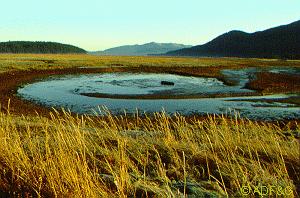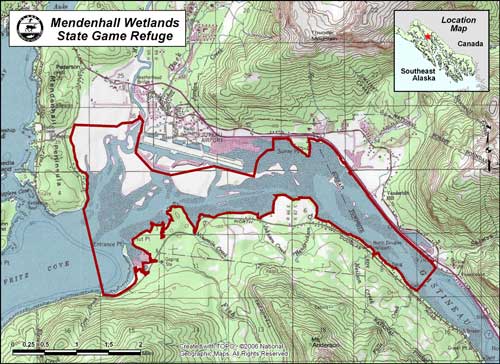Mendenhall Wetlands —
State Game Refuge
Area Overview
History
 Land and sea meet and intermingle in saltwater wetlands. When fresh water flows into
this mixture, the result is a diverse habitat that supports varied plant and animal life. Mendenhall
Wetlands State Game Refuge at Juneau, Alaska provides a vital feeding and resting area for both resident
birds and migrants traveling to and from their Arctic breeding grounds. The 4,000-acre wildlife refuge
stretches nine miles along the shores of Gastineau Channel near the heart of Alaska's capital city.
Land and sea meet and intermingle in saltwater wetlands. When fresh water flows into
this mixture, the result is a diverse habitat that supports varied plant and animal life. Mendenhall
Wetlands State Game Refuge at Juneau, Alaska provides a vital feeding and resting area for both resident
birds and migrants traveling to and from their Arctic breeding grounds. The 4,000-acre wildlife refuge
stretches nine miles along the shores of Gastineau Channel near the heart of Alaska's capital city.
Millennia ago, glaciers sculpted the complex of waterways and islands known as southeast Alaska. Even today, the dynamic forces of glaciation are at work. These forces are evident in the Mendenhall Refuge. As the massive glaciers retreat up their carved valleys, rivers flow from the melting ice. Ground rock and silt carried by the rivers are deposited on the flats of Gastineau Channel. The wetlands are building up from waste materials left by three major glaciers: the Mendenhall Glacier is at the head of the Mendenhall Valley, the Thomas Glacier is visible from the Egan Expressway at Lemon Creek, and the Lemon Glacier is at the head of Lemon Creek.
At the same time, the wetlands are rising slowly as they are relieved of the enormous weight of the retreating glaciers. This process is called "isostatic rebound."
Human activity has only recently affected the character of the Mendenhall Wetlands. In the 1930s, a small landing strip was built, a portion jutting into the wetlands. Today, the Juneau airport continues to expand into the surrounding area. In the late 1950s, the U.S. Army Corps of Engineers dredged a navigational channel to give small fishing and pleasure boats a shortcut from Juneau to northern Stephens Passage. Much of the dredged material was dumped onto the wetlands where it remains in the form of sand islands.
 The accelerating rate of change prompted many local citizens to urge creation of a refuge to protect
the wildlife and recreational values of the wetlands. The move to conserve the wetlands grew with
construction of the Egan Expressway in the early 1970s. After more than a decade of citizen involvement,
the Mendenhall Wetlands State Game Refuge was established in 1976.
The accelerating rate of change prompted many local citizens to urge creation of a refuge to protect
the wildlife and recreational values of the wetlands. The move to conserve the wetlands grew with
construction of the Egan Expressway in the early 1970s. After more than a decade of citizen involvement,
the Mendenhall Wetlands State Game Refuge was established in 1976.
The Mendenhall Wetlands State Game Refuge is enjoyed year-round by residents and visitors alike. Waterfowl hunting, hiking, wildlife viewing and photography, boating, fishing, scientific and educational studies, and sightseeing are popular activities supporting approximately 20,000 user days annually. The streams flowing into the refuge support an estimated 400 days of fishing effort each year. Coho s almon is the most frequently taken fish, followed by cutthroat trout, sockeye salmon, and Dolly Varden. Waterfowl hunters expend over 2,000 hunter days and take over 3,000 ducks annually on the refuge.
For more information on the Mendenhall Wetlands State Game Refuge please refer to the Mendenhall Wetlands Management Plan. For current land status information, see the Mendenhall Wetlands Land Status Map (PDF 1,384 kB). You may also download the KML file which depicts the refuge area boundary.
More Resources

